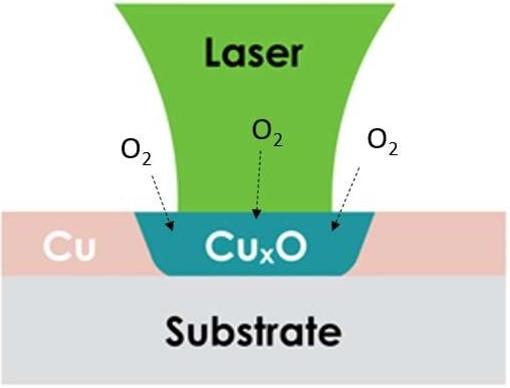There is a general need for strategies to fabricate functional devices with tailored properties for specific applications at low cost; optical applications include deep UV photodetectors, flexible or wearable sensors, tunable flat optics including optical phase plates and Fresnel lenses with high laser damage performance.
LLNL researchers developed a novel strategy that involves material transformations such as oxidation, nitridation, or carbonization. In one embodiment, copper is heated under ambient conditions resulting in its surface being oxidized and turned into copper oxide, where a new material (e.g., copper oxide) is developed via transformation (e.g., oxidation) without additional addition deposition step. As a result, multiple materials can be generated without needing multiple deposition processes. For instance, two different types of copper oxide (e.g., Cu2O and CuO2) can be selectively obtained from copper by controlling the oxidation conditions.
Image Caption: Schematic showing how laser can be used to induce localized heating and produce oxidation layer of a sample on a motorized stage that is exposed to oxygen in the air
- Allows functional devices to be fabricated very simply and cost-effectively by laser-induced oxidation transformation.
- Capability to design targeted materials with designed height profile can open up a broad range of never-before considered applications.
- Transformed materials have distinctive properties (e.g., electrical, optical, chemical) from their host material.
- Transform electrically conductive metals into semiconducting oxides with tailored electrical properties yielding a photodetector in a single transformation step without multiple lithography and deposition steps.
- Produce optical phase plates in a single transformation step instead of the usual process of multiple lithography process steps.
- Design optical filters with spatially changing transmission profiles by selectively transforming optically opaque materials into optically transparent ones.
Current stage of technology development: TRL 2-3
LLNL has filed for patent protection on this invention.
U.S. Patent Application No. 2023/0241718 System and Method for Transformative Interface/Surface Painting (TRIP) for Arbitrary 3D Surface/Interface Structures published 8/3/2023


